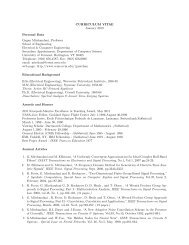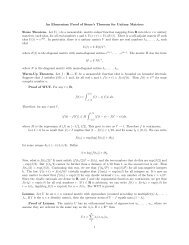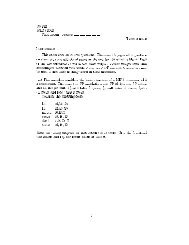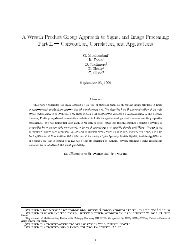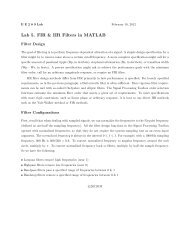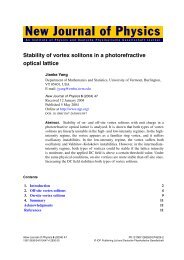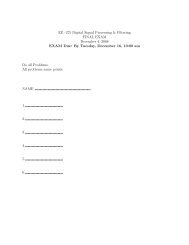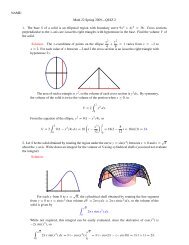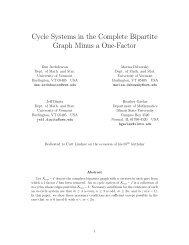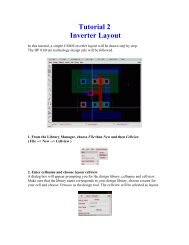Weighted inequalities for gradients on non-smooth domains ...
Weighted inequalities for gradients on non-smooth domains ...
Weighted inequalities for gradients on non-smooth domains ...
You also want an ePaper? Increase the reach of your titles
YUMPU automatically turns print PDFs into web optimized ePapers that Google loves.
The key to our argument lies in defining the right maximal functi<strong>on</strong>. Let us assume that wehave a fixed finite linear combinati<strong>on</strong> f = ∑ Q λ Qφ (Q) .IfI ∈D,wedefineS(I) ≡{Q ∈D: Q ⊄ I}.It is useful to think of S(I) as the family of dyadic cubes that “surround” I. Ifx ∈ I, wedefineF (I,x) ≡∑Q:Q∈S(I)λ Q φ (Q) (x),and we do not define F (I,x)<str<strong>on</strong>g>for</str<strong>on</strong>g>x/∈ I. Ifx I is the center of I, then we set F (I) ≡ F (I,x I ). Theright maximal functi<strong>on</strong> <str<strong>on</strong>g>for</str<strong>on</strong>g> the Littlewood-Paley functi<strong>on</strong> g ∗ (f) turns out to beF ∗ (x) ≡ sup |F (I)|.I:x∈ICorresp<strong>on</strong>ding to F ∗ (x) is a “maximal square functi<strong>on</strong>” adapted to g ∗ (f). For x ∈ I, wedefine⎛G(I,x) ≡ ⎝ ∑Q∈S(I)⎡∞∑|λ Q | 2 ⎣j=02 −j(2α−τ)⎤⎞ω(2 j Q) χ R j (Q)(x) ⎦⎠and we do not define G(I,x)<str<strong>on</strong>g>for</str<strong>on</strong>g>x/∈ I. We similarly define G(I) ≡ G(I,x I )andG ∗ (x) ≡ sup G(I).I:x∈IIn order to prove Theorem 1.1, we shall prove seven fairly elementary lemmas, followed by adifficult lemma, which is really the heart of the proof of Theorem 1.1. These lemmas are directlyanalogous to, respectively, Lemmas 1–7 and Lemma 1.9 in [Wi]. Our more general <str<strong>on</strong>g>for</str<strong>on</strong>g>mulati<strong>on</strong> ofthe φ (Q) ’s requires us to surmount some n<strong>on</strong>-trivial technical obstacles.Lemma 1.2. For ω-a. e. x, |f(x)| ≤F ∗ (x).Proof. The inequality is obviously true Lebesgue almost everywhere. However, the <strong>on</strong>lyexcepti<strong>on</strong>al points lie <strong>on</strong> the faces of dyadic cubes, and these have ω-measure 0, because ω isdoubling. QED.Lemma 1.3. There is a c<strong>on</strong>stant C such that G ∗ (x) ≤ Cg ∗ (f)(x) almost everywhere.Proof. Let I ∈Dand x ∈ I. We need to show that G(I) ≤ Cg ∗ (f)(x), <str<strong>on</strong>g>for</str<strong>on</strong>g> which it is clearlysufficient to show that⎡⎤(G(I)) 2 ≤ C∑∞∑|λ Q | 2 ⎣2 −j(2α−τ)ω(2 j Q) χ R j (Q)(x) ⎦ ,where (recall the definiti<strong>on</strong> above)(G(I)) 2 =Q:Q∈S(I)∑Q:Q∈S(I)j=0⎡∞∑|λ Q | 2 ⎣j=072 −j(2α−τ)1/2⎤ω(2 j Q) χ R j (Q)(x I ) ⎦ .,



